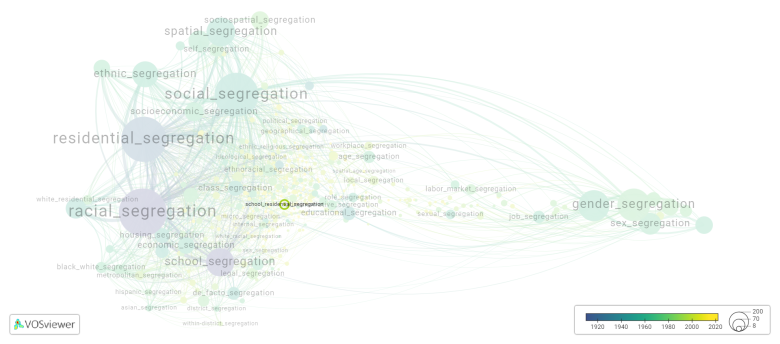School residential segregation: Difference between revisions
(Creating page) |
(Creating page) |
||
| (13 intermediate revisions by the same user not shown) | |||
| Line 1: | Line 1: | ||
===== Date and country of first publication<ref>Date and country of first publication as informed by the Scopus database (December 2023).</ref>===== | |||
2006<br> | 2006<br> | ||
United States | |||
===== Definition ===== | |||
School residential segregation refers to the separation of students based on their residential location or neighborhood. This segregation occurs when students from different socioeconomic backgrounds and racial or ethnic groups are concentrated in specific neighborhoods or communities, leading to unequal access to quality education. | School residential segregation refers to the separation of students based on their residential location or neighborhood. This segregation occurs when students from different socioeconomic backgrounds and racial or ethnic groups are concentrated in specific neighborhoods or communities, leading to unequal access to quality education. | ||
| Line 12: | Line 14: | ||
Efforts to address school residential segregation include implementing policies to promote fair housing practices, providing transportation options to allow students to attend schools outside their residential zones, and promoting diversity and integration in schools. These efforts aim to ensure that all students have access to quality education regardless of their residential location. However, achieving true residential integration and eliminating school residential segregation remains a complex and ongoing challenge. | Efforts to address school residential segregation include implementing policies to promote fair housing practices, providing transportation options to allow students to attend schools outside their residential zones, and promoting diversity and integration in schools. These efforts aim to ensure that all students have access to quality education regardless of their residential location. However, achieving true residential integration and eliminating school residential segregation remains a complex and ongoing challenge. | ||
==See also== | ==See also== | ||
==Related segregation forms== | |||
School residential segregation is frequently discussed in the literature with the following segregation forms: | |||
[[racial residential segregation]], [[residential segregation]], [[school friendship segregation]] | |||
[[File:school_residential_segregation.png|780x780px]] | |||
This visualization is based on the study [[Segregation_Wiki:About| The Multidisciplinary Landscape of Segregation Research]]. | |||
For the complete network of interrelated segregation forms, please refer to: | |||
* [https://tinyurl.com/2235lkhw First year of publication] | |||
* [https://tinyurl.com/2d8wg5n3 Louvain clusters] | |||
* [https://tinyurl.com/223udk5r Betweenness centrality] | |||
* [https://tinyurl.com/244d8unz Disciplines in which segregation forms first emerged (Scopus database).] | |||
==References== | ==References== | ||
== | ==Notes== | ||
<references /> | |||
{{NoteAI}} | |||
==School residential segregation appears in the following literature== | |||
Mouw T. | Mouw T., Entwisle B. (2006). Residential segregation and interracial friendship in schools. ''American Journal of Sociology'', ''112''(2), 394-441. https://doi.org/10.1086/506415 | ||
Latest revision as of 07:17, 16 October 2024
Date and country of first publication[1][edit | edit source]
2006
United States
Definition[edit | edit source]
School residential segregation refers to the separation of students based on their residential location or neighborhood. This segregation occurs when students from different socioeconomic backgrounds and racial or ethnic groups are concentrated in specific neighborhoods or communities, leading to unequal access to quality education.
Residential segregation can be both socioeconomic and racial/ethnic in nature. Socioeconomic segregation refers to the clustering of students from similar income levels or socioeconomic statuses in specific neighborhoods. This can result in schools in low-income neighborhoods having fewer resources and less funding, leading to lower-quality education compared to their counterparts in wealthier areas.
Racial and ethnic segregation occurs when students from different racial or ethnic backgrounds are concentrated in specific neighborhoods. This segregation can lead to disparities in educational opportunities, as schools in racially segregated areas may have limited resources, less-experienced teachers, and higher student-to-teacher ratios compared to schools in more diverse or affluent areas. This can result in unequal educational outcomes and perpetuate educational and socioeconomic inequalities.
Residential segregation is influenced by historical and ongoing factors such as discriminatory housing practices, redlining, and socioeconomic disparities. Additionally, the self-segregation of families based on socioeconomic or racial/ethnic backgrounds also contributes to residential segregation.
Efforts to address school residential segregation include implementing policies to promote fair housing practices, providing transportation options to allow students to attend schools outside their residential zones, and promoting diversity and integration in schools. These efforts aim to ensure that all students have access to quality education regardless of their residential location. However, achieving true residential integration and eliminating school residential segregation remains a complex and ongoing challenge.
See also[edit | edit source]
Related segregation forms[edit | edit source]
School residential segregation is frequently discussed in the literature with the following segregation forms:
racial residential segregation, residential segregation, school friendship segregation

This visualization is based on the study The Multidisciplinary Landscape of Segregation Research.
For the complete network of interrelated segregation forms, please refer to:
References[edit | edit source]
Notes[edit | edit source]
- ↑ Date and country of first publication as informed by the Scopus database (December 2023).
At its current state, this definition has been generated by a Large Language Model (LLM) so far without review by an independent researcher or a member of the curating team of segregation experts that keep the Segregation Wiki online. While we strive for accuracy, we cannot guarantee its reliability, completeness and timeliness. Please use this content with caution and verify information as needed. Also, feel free to improve on the definition as you see fit, including the use of references and other informational resources. We value your input in enhancing the quality and accuracy of the definitions of segregation forms collectively offered in the Segregation Wiki ©.
School residential segregation appears in the following literature[edit | edit source]
Mouw T., Entwisle B. (2006). Residential segregation and interracial friendship in schools. American Journal of Sociology, 112(2), 394-441. https://doi.org/10.1086/506415
